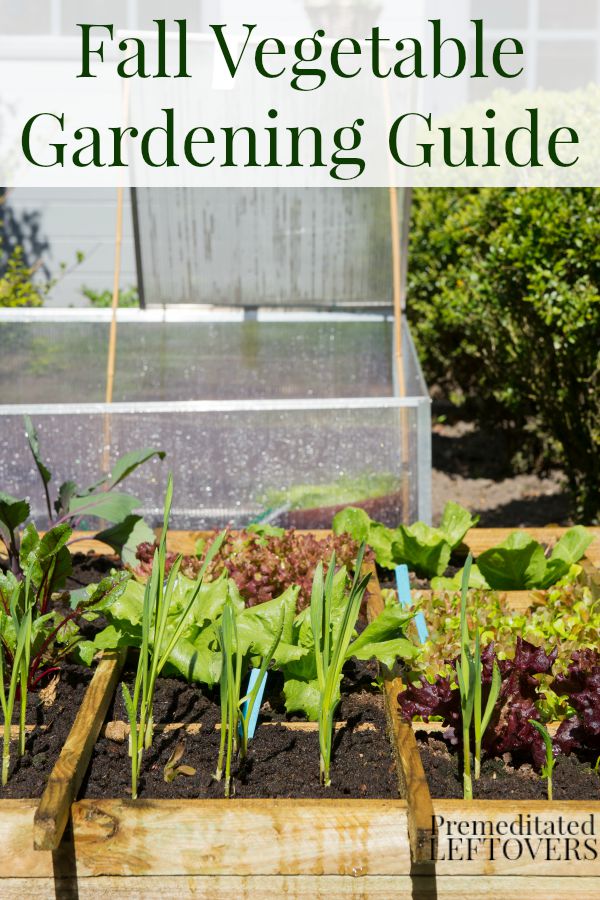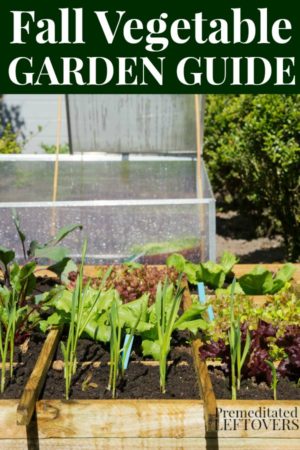Use this Fall Vegetable Gardening Guide to extend your garden by growing vegetables in autumn. Includes a list of plants that grow well in cool weather and tips for fall gardening.
Fall brings cool weather and a mild cold front that cool weather vegetables need in order to flourish. During the fall months you will notice your lettuce growing faster. Its crops become darker, sweeter, and crisper. When you carry cabbage, cauliflower and broccoli into the fall season you will see uninterrupted growth. Increase your vegetable bed with fall vegetables that don’t do well in the summer heat to extend your growing season. With a well thought out plan you could be saving hundreds of dollars by growing your own vegetables and you will have little need to visit the produce market.
Planning your fall garden is easy if you know what you can plant. There are a lot of vegetables that are cool weather cops so I suggest making a list of the things you are currently buying at the produce market and start growing those things first and then add a couple new things. You can always add more next year.
Vegetables that Grow Well in Cool Weather:
- garlic
- endive
- kale (How to Grow Kale)
- chicory
- carrots (How to Grow Carrots)
- Swiss chard (How to Grow Swiss Chard)
- broccoli (How to Grow Broccoli)
- cauliflower (How to Grow Cauliflower)
- cabbage (How to Grow Cabbage)
- beets (How to Grow Beets)
- radishes (How to Grow Radishes)
- turnips
- bush beans
- Brussels sprouts (How to Grow Brussels Sprouts)
- Chinese cabbage
- kohlrabi (How to Grow Kohlrabi)
- onions (how to grow larger onions)
- leeks
- chives
- mustard greens
- lettuces (How to grow gourmet lettuces.)
- peas (How to Grow Peas)
- fava beans
All of the listed plants can be started by seed indoors in early summer and then brought out to transplant in late summer or early fall. Plant all fall crops before the first frost so they have plenty of time to settle their roots in the ground.
Fall Vegetable Gardening Guide:
- Check germination and days to harvest time on the seed packets so you know when to expect plants to become ready for harvest. As an example, radishes are quick producing plants so you can expect them to be ready within 25 to 30 days. It does depend on the type of radish you are planting so you would want to check the back of your seed packet.
- Use good soil in your beds. Soil plays an important part in the success of your garden. Low-quality soil has a poor concentration of pH balance and will eventually kill your plants. It may not happen this year but eventually, the pH balance will be so poor that the plants won’t be able to survive. You can purchase specialty soil made for home vegetable gardening from most nurseries but it isn’t difficult to mix your own soil at home. You can even ask a nursery worker what they suggest for mixing. Typically you’ll do equal parts of fertilizer to the soil and add in things like mulch, perlite, vermiculite, sand, or shell materials.
- Fertilize your crop using a product that is safe for vegetables such as chicken manure, miracle grow or homemade fertilizer. Fertilizing needs vary by the type of plant so check the back of your seed packet for fertilizing suggestions.
The secret to having a successful fall vegetable garden is to have a well thought out plan. You must use the summer season to carry over plants into the fall months, replace plants that you pull up and add fall crops to your beds for a continuous supply of produce.
More Fall Gardening Tips
How to Collect Vegetable Seeds
How to Make Leaf Mold to Use in Organic Gardening
How to Grow More in Your Square Foot Garden with Succession Gardening



Sabra says
Hi.
Are all these suggestions good for all climes zones or just certain ones. I live in zone 9a.
Terri says
My tomatoes plants are still producing tomatoes they’re not turning red through and not getting real big but big enough for fried green tomatoes.My cucumbers are doing real good still.
Marymarie says
Question: can strawberry plants be grown successfully using the straw bale method?
It seems to me that would be a good match.